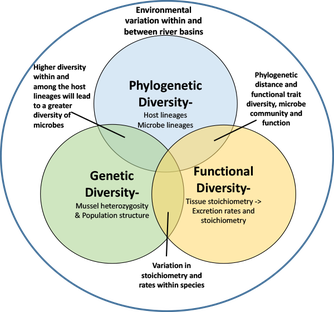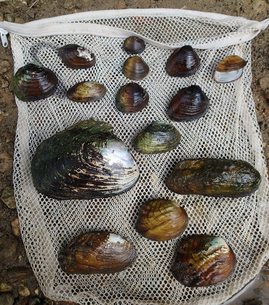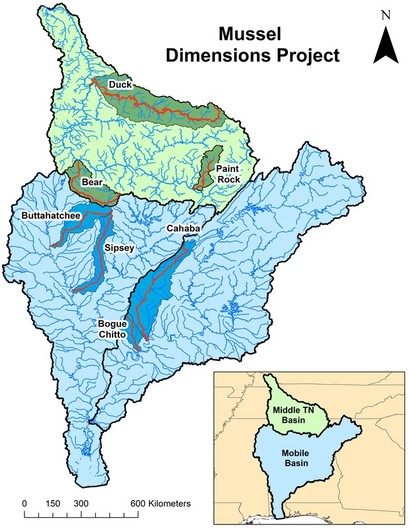Investigating the Dimensions of biodiversity in the mussel holobiont
|
A major goal in evolutionary ecology is to understand the relationships among genetic diversity, community assembly, and ecosystem function. There are crucial unresolved questions relating to how intraspecific (genetic) and species-level (phylogenetic) diversity are related within and among communities, and how these characteristics translate into ecosystem function through expression of key functional traits. Our project incorporates data on the environment, freshwater mussel community diversity, genetic diversity and differentiation in mussel species, phylogenetic relationships among mussels and their bacterial microbiomes, and functional trait diversity to provide a hierarchical perspective to community assembly at different scales of biological organization.
Diversity of Freshwater MusselsThe freshwater mussels (Order: Unionoida) are a species-rich group of long-lived (6-100+ years) filter-feeding organisms that form dense aggregations in rivers. The southeastern US is the global diversity hotspot of freshwater mussels. While mussels once dominated the benthic biomass in many southeastern rivers, they are now among the most imperiled faunal group, with 72% of species being imperiled. Further, species-level relationships, connectivity amongst different populations, the role of their gut microbial communities, and the function and effects of biodiversity within systems on ecological function are poorly understood. This project sets at the forefront of better understanding the drivers of biodiversity within this group and other riverine fauna, which will also hopefully inform future conservation efforts on this group.
The Mussel-Microbe HolobiontAnimals harbor a diverse community of microorganisms. This has led to the emerging concept of the holobiont – that the functional organism is the sum of the interactions between the host and its microbiome. However, the extent to which intra- and interspecific aspects of host and microbiome diversity influence the functional diversity of the the interacting host and microbiome, or how the host and microbiome together influence ecosystem function, is still unknown. This represents a substantial gap in our understanding of global biodiversity across different levels of biological organization.
Little is known of the microbial communities inhabiting freshwater mussels, despite continual exposure to microbes through their aquatic habitat and filter-feeding on suspended particles and bacterioplankton. Since freshwater mussels are aquatic filter feeders that are constantly immersed in and take in microbiota from the surrounding water, they offer a unique opportunity to tease apart the connections between host genetics and phylogeny, environmental variation, and microbiome ecological and phylogenetic diversity. |
|




